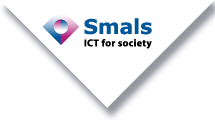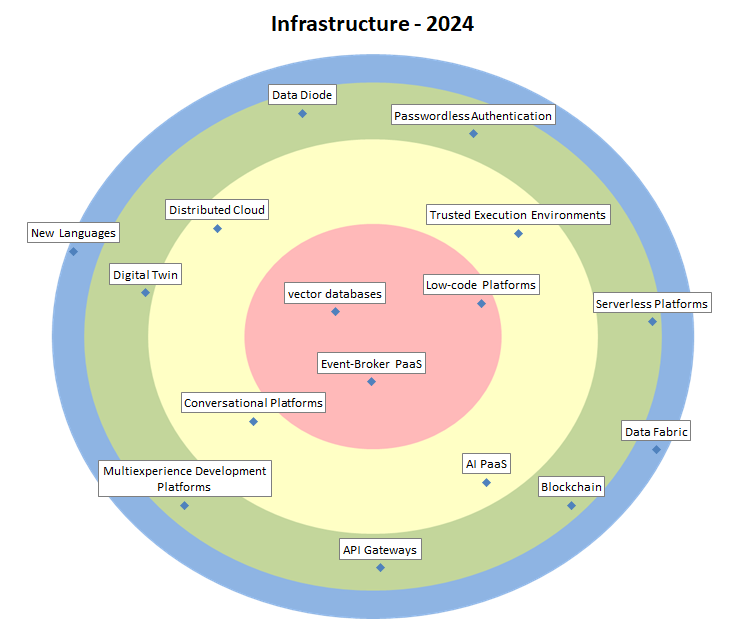Infrastructure, Platforms, Servers, Networking, Datacenter, Appliances, …
| Low-code Platforms | = | Platforms or frameworks on which developers, and sometimes also business stakeholders, can more rapidly build applications. Delivered through PaaS or as libraries, they are often characterised by the use of graphical programming methods, for GUI but also for the logic. |
| Event-Broker PaaS | + | The heart of an event system, a kind of middleware for EDA. This is, or can be used to build, the Event Bus. These platforms take care of the publish and subscribe mechanics, the delivery guarantees, and sometimes storage and replay. |
| vector databases | N | Vector databases are a type of database that index and store high-dimensional vector embeddings for fast retrieval and similarity search. They support use cases like semantic search, recommendation and generative question answering applications. |
| Trusted Execution Environments | – | A trusted execution environment (TEE) is designed to reside alongside a regular execution environment (inc. operating system) to provide a safe area to protect assets and execute trusted code. It is an important building block to enable confidential computing. |
| AI PaaS | = | AI Platform as a Service (PaaS) provides AI model building tools, APIs and associated middleware that enable the building/training, deployment and consumption of machine learning models running on prebuilt infrastructure as cloud services. |
| Conversational Platforms | = | Conversational platforms support the development of conversational interfaces based on intent and entity recognition, context handling, exception handling, messaging platform connectors and monitoring/analytics. |
| Distributed Cloud | = | Implementation of public cloud services in the datacentre of an organisation (or another physical location). As such, latency will be better (at the edge) and data remains on site. Operation, governance, updates and evolution of the services are the responsibility of the public cloud provider. |
| Passwordless Authentication | – | Passwordless authentication refers to authentication methods in which a user logs in to a computer or application without entering (and remembering) a password or any other knowledge-based secret. The goal is to provide a higher level of security and convenience. |
| Serverless Platforms | – | This architecture allows to simply send code, based on handler templates, to a ‘Function Platform as a Service’ (FPaaS). It can then immediately be run without any server or middleware setup. Scalability, robustness, and many other non-functional requirements are handled by the platform. |
| Blockchain | = | Blockchain enables decentralised verification of rules as well as tamper-proof storage. This may reduce the dependency on central parties. It is being touted as a technology to increase transparency and reduce friction in e.g. transactional processes and supply-chain management. |
| API Gateways | = | A platform to manage an organisation’s APIs. They act as gatekeepers, controlling (and metering, billing) access and making centralised security policy enforcement possible, but also providing documentation and helping developers use the APIs |
| Multiexperience Development Platforms | = | Tooling set for developers (front-end development tools and back-end services) to support mobile, modern web, wearable, conversational and AR development, ensuring a consistent user experience across all those interfaces/channels so that users can accomplish their activity seamlessly. |
| Digital Twin | = | A digital twin is a dynamic virtual copy of a physical asset, process, system, network, environment or even a person that behaves identically to its real-world counterpart. A digital twin is used to predict possible performance outcomes and issues that the real-world counterpart might undergo. |
| Data Diode | N | A data diode is a unidirectional communication and data transfer gateway that enables organisations to transfer data securely across physically separated networks. It prevents data leakage and eliminates threats by enforcing one-way data transfer at both the physical & protocol layers |
| Data Fabric | – | The data fabric is a distributed data management platform that supports data integration and data sharing. The data fabric can connect to multiple data sources with minimal coding and be accessible to multiple applications. It also eases data sharing between cloud and on-premise data centres. |
| New Languages | = | Some new upcoming programming languages have interesting properties regarding efficiency/security/robustness/scalability (Rust, Kotlin, WebAssembly, …) that might be useful in particular use cases. |

